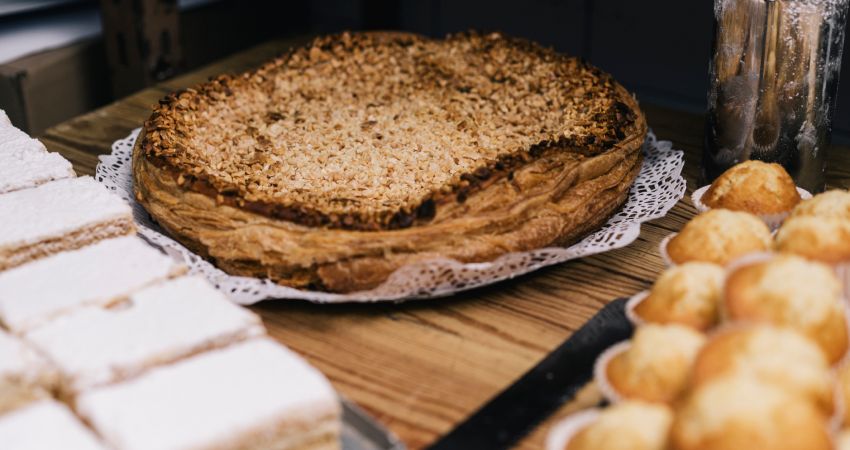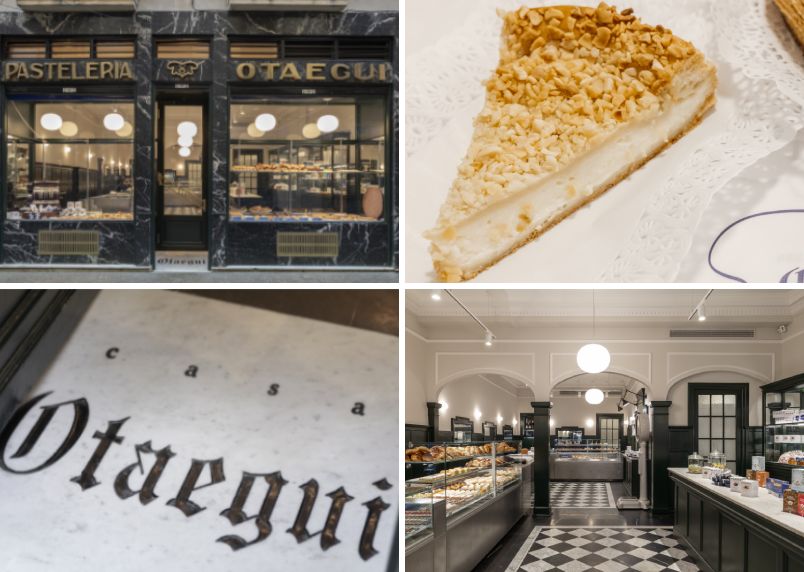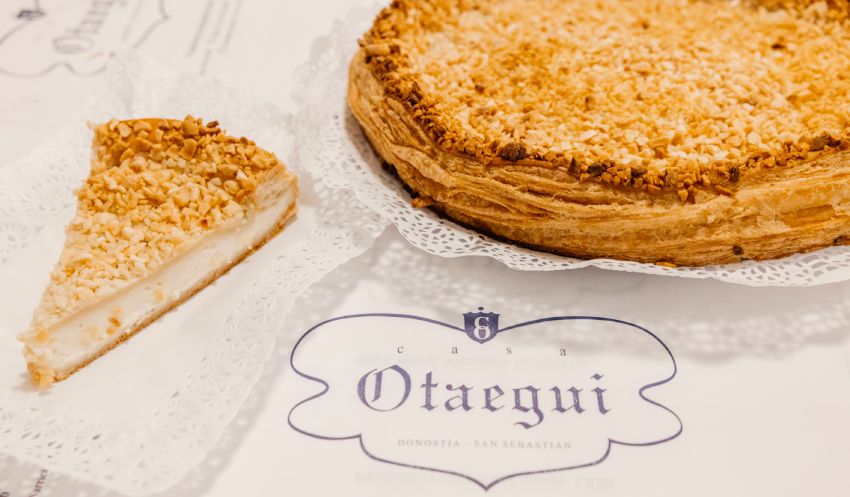Panchineta®: San Sebastián’s Iconic Basque Dessert
- Food and drink
- 2025 Apr 09
So, what exactly is the Panchineta®?
To understand the panchineta’s global appeal, you must first understand what it is. At first sight, the panchineta (pronounced ‘pahn-chee-NET-ah’) appears to be a simple circle of puff pastry with a sprinkling of almonds. When you cut a slice, however, the magic of the tart is revealed: two layers of buttery, flaky puff pastry sprinkled on top with chopped, lightly toasted Marcona almonds and sandwiched with pastry cream. Simple, right?
But what is the real secret? According to Iñigo Otaegui, one of the family members that runs Casa Otaegui, it’s the fact the dessert is made using local products, always from the same providers. “We work with Harinas de Navarra, and the milk we get from Kaiku,” says Iñigo. “Nowadays, everyone talks about sustainability and slow food, but we’ve always worked that way.” Of course, apart from the quality of its ingredients, there is a recipe, the original recipe of Casa Otaegui, one of the city’s best-kept secrets.
Iñigo Otaegui
 Photo: Alex Iturralde - Casa Otaegui
Photo: Alex Iturralde - Casa Otaegui
The history of Casa Otaegui
The history of this iconic San Sebastián dessert is inseparable from the history of its creators, the Otaegui family. In 1886 the bakery opened its doors, as a general store, or tienda de ultramarinos, with an assortment of pantry staples and delicacies. Founded by Pedro Otaegui and Josefina Malcorra, it was left to their daughter Emiliana Malcorra. Emiliana’s husband died young, leaving her and her nine children to run the business, which she called Viuda Otaegui, or Widow Otaegui.
At that moment, the bakery itself was located in the basement of the current shop, where you can find the original almost 10-foot-long wooden worktable that still smells, to this day, of butter and pastry dough. While the basement is no longer home to Otaegui’s production, it still houses the treasures and remnants of the family’s past, from centuries-old glass jars to the shelves used to stow clients’ hats when there was a café above.
Nowadays, the bakery is run by the fourth and fifth generation, an incredible feat made possible by their sheer commitment to maintaining tradition and doing things the “right” way. An insistence on using artisan techniques means the pastries, tartes and cakes they sell taste just like they did decades ago, making it one of the city’s favorite bakeries, and not just for the panchineta.
Locals also frequent Otaegui for their tempered chocolate with hazelnuts, their extensive menu of cakes for celebrations, and for their tiny tea cookies.
 Photos: Pablo Axpe and Alex Iturralde - Casa Otaegui
Photos: Pablo Axpe and Alex Iturralde - Casa Otaegui
The history of the Panchineta®
It often happens that famous dishes exist in a vacuum, with no way to trace their origins. In the case of the panchineta, however, its origins can be traced to a delicious-smelling bakery in 1930s San Sebastián.
When World War I broke out, neutral Spain became a place for the rest of Europe’s noble class to flee. Many of the chefs, cooks and servants that formed the coterie of the royals ended up staying in San Sebastián, employing their talent in local restaurants and bakeries, like Casa Otaegui.
As Spain entered into the 1930s, civil war broke out, dragging the country deeper into poverty and scarcity.
These two factors were key in the creation of the panchineta. “The panchineta was born of this scarcity, this necessity,” says Maria Otaegui. “After all, in a bakery you have eggs, you have flour. And with the influence of these bakers, all this combined and the panchineta was born.”
The pastry was an immediate hit. Now, over 80 years later, on the busiest weekends Casa Otaegui can sell more than 1,000 panchinetas.
Maria Otaegui
 Photo: Alex Iturralde - Casa Otaegui
Photo: Alex Iturralde - Casa Otaegui
When, how and where to eat Panchineta®
The delicious history of the panchineta is enough to get your mouth watering, but it’s only half the equation. The other half is, of course, tasting it in person. You can find the original Otaegui panchineta on the dessert menu at a few restaurants in town, but the best place to try it is the flagship pastry shop itself, on Calle Narrika in the old town of San Sebastián.
They arrive fresh several times a day, delivered by hand from the nearby bakery workshop. The convenient location of the pastry shop, right on the doorstep of many of the city’s best pintxo bars, means it makes a perfectly sweet ending to any pintxo hop as well.
To eat it like a local, you can grab a piece for hamaiketako, a snack taken around 11 in the morning, and enjoy it with a bitter espresso. Or take a whole tart with you to share with friends at a special meal, just like any donostiarra has done at least once in their lifetime.
There is no doubt that the best way to truly understand is to get yourself a freshly baked panchineta and dig in.


